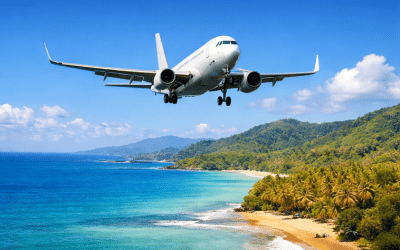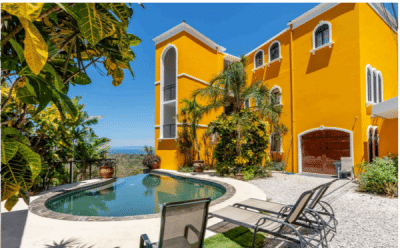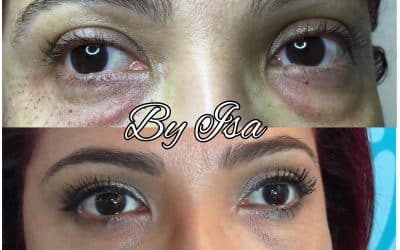Costa Rica wraps everything the modern wellness seeker wants into one daily rhythm: jungle adventures and surf before breakfast, marimba and gallery nights for culture and entertainment, scarlet macaws looping overhead for wildlife, property choices that put nature first for real estate, a stable and growing market for business, and food that runs from farmers’ market papayas to ocean-fresh ceviche and farm-to-table casados. It’s the ideal backdrop for homes designed to help you feel better, live cleaner and stay connected—to people and to place.
What is wellness real estate—and why is it booming?
Wellness real estate is housing planned to support physical, mental and environmental health, and it’s growing because buyers want homes that actively improve everyday life. In Costa Rica, that translates to nature-cooled designs, toxin-light materials, on-site yoga and spa rituals, and communities shaped around clean food, calm sleep and easy movement.
Where can you find standout wellness communities in Costa Rica?
You’ll find them from the Pacific to the Central Valley, with options to match beach lovers, mountain hikers and city-adjacent families.
- Guanacaste coastal retreats: Ocean-view homes with open-air yoga pavilions, lap and plunge pools, and board-in-hand beach access for surf, SUP and sunrise runs—ideal for people who want wellness baked into the day, not squeezed in after work.
- Central Valley eco-villages: Regenerative communities with food forests, river dips and meditation nooks, plus quick links to schools, shops and services—great for full-time families who still want a gentle, nature-first rhythm.
- Resort-branded residences: Full spa menus, movement studios and clinical-grade recovery facilities paired with five-star management—perfect for lock-up-and-leave owners who expect professional standards and reliable rental support.
- Boutique mountain sanctuaries: Cooler temperatures, cloud-forest trails and spring-fed water systems, with homes tucked among trees—made for quiet seekers who value birdsong, misty mornings and serious privacy.
Which home features actually make you healthier?
Features you’ll use every single day—rather than just photograph—make the real difference.
- Clean air and daylight: Cross-ventilation, deep roof overhangs, operable shading, low-VOC finishes and circadian-aware lighting to improve sleep, focus and mood while reducing reliance on air-con.
- Movement and recovery: Shaded yoga decks, strength corners, woodland or beach trails, and cold-plunge/sauna combos with quiet lounges—so you can train, unwind and reset your nervous system without leaving home.
- Food and water: Organic kitchen gardens, edible landscaping, composting, rainwater harvesting and robust filtration—turning “clean eating” and hydration into easy, daily habits.
- Acoustic comfort: Sound-dampened walls, silent appliances and clever room layouts—bedrooms that actually restore you, even when the howlers kick off at dawn.
- Nature-positive systems: Native planting, wildlife corridors, greywater reuse and soil care—supporting biodiversity and lowering long-term maintenance costs.
Is the investment case compelling?
Yes—where wellness is authentic and the location is strong, rental yield and resale interest can outperform generic stock. Demand is fuelled by:
- Year-round lifestyle travel: Remote workers, surf and yoga travellers, retreat groups and long-stay families who pay for healthy routines on tap.
- Strong brand pull: Reputable resort operators and credible eco-villages maintain programmes and standards, which protects rents and reviews.
- Scarcity premium: Limited coastal inventory and high buyer preference for nature-first, low-toxin living keep well-built homes in short supply.
Who is buying these homes—and why?
Buyers from the U.S. and Europe choose Costa Rica for safety, access, biodiversity and year-round outdoor living. They consistently look for:
- Ease: Direct flights, modern clinics, fibre internet and bilingual services that make a healthy life logistically simple.
- Community: Neighbours who share active routines, social gardening and a light-footprint mindset—instant alignment of values.
- Purpose: Properties that align investment with personal health and environmental stewardship, so money and meaning move together.
How do I evaluate a wellness development before I buy?
Use a practical “proof of use” checklist to separate substance from marketing.
- Watch daily life: Are yoga classes full, gardens productive and trails maintained, or are amenities mostly photo props? Observe morning and evening.
- Ask for specs: Ventilation rates, material lists, acoustic treatments and water/energy strategies should be documented—not guessed.
- Verify permits and water: Confirm water letters, treatment systems and environmental approvals; understand dry-season resilience.
- Inspect operations: Who runs the spa, classes, gardens and rentals? Review HOA budgets, staffing plans and maintenance logs for continuity.
- Map the lifestyle radius: Beaches and trails, markets, schools, clinics and airports should be reachable without stressful drives.
- Benchmark peers: Compare against respected eco-villages and resort-managed residences to gauge build quality, programme depth and community culture.
What does it cost—and what ongoing fees should I expect?
Budgets depend on view, build quality and brand. Expect:
- Purchase: Lower entry points for compact inland eco-homes; a premium for ocean-view or resort-branded residences with full services.
- Running costs: HOA fees for trails, gardens, security and wellness programming; utilities shaped by passive cooling, shading and any solar.
- Optional extras: On-site spa treatments, personal training, private chefs and seasonal retreat programmes—pay-as-you-choose lifestyle upgrades.
How do I live the wellness lifestyle day-to-day in Costa Rica?
Keep it simple, seasonal and local.
- Morning routine: Sun salutations on a shaded deck, a trail run or paddle, then coffee and fruit from the feria—movement, light and nutrition before emails.
- Midday reset: Ocean swim, cold plunge or hammock nap in a naturally cool, cross-breezed bedroom—fifteen minutes that changes the afternoon.
- Afternoon connection: Community gardening hour, kids spotting iguanas on the nature trail, neighbours sharing mangos and recipes—wellness as social glue.
- Evening wind-down: Sound bath, gentle stretch or a book on the terrace; pescatarian supper with herbs you cut minutes earlier—sleep set-up starts at dinner.
FAQ
Is wellness real estate just a marketing term? No—done properly, it blends sound building science with daily programmes, food access and low-toxin operations you actually use.
Do these homes rent well? Yes—near beaches, clinics and airports, properties with credible programming often achieve strong occupancy and rates.
Can I find entry-level options? Yes—look slightly inland or in smaller eco-villages where compact footprints trim costs without sacrificing the lifestyle.
What paperwork is unique to Costa Rica? Confirm water availability, environmental permits and HOA bylaws; ensure land-care plans are realistic for dry and green seasons.
Will I need a car? Often yes, though walkable layouts, e-bikes and golf carts can cover most daily needs inside many communities.
Costa Rica makes healthy living wonderfully ordinary. From teak yoga platforms above a blue bay to cloud-forest homes cooled by river breezes, the country turns wellness from a weekend treat into an everyday habit—supported by community, nourished by fresh food and amplified by the wild world just beyond your doorstep.






